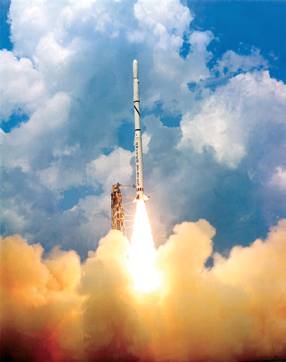In the early days of spaceflight, NASA principally used launch vehicles developed from the Atlas, Thor and Titan military missiles for the bulk of its general launch requirements.

However, NASA also had the requirement for a simple, low-cost and reliable vehicle that could be used for sub-orbital and orbital flights. These were envisaged to include Earth and space sciences missions, development of engineering and communications technologies as well as navigational techniques and re-entry experiments.
Development of the Scout launch vehicle by Chance Vought, later LTV, began in May of 1958 to meet this NASA requirement. The vehicle that evolved was built up from a number of existing solid fueled rockets and has been improved over the years. Scout was an acronym for Solid Controlled Orbital Utility. A typical Scout vehicle consisted of four stages.
• The first stage, with a length of 9.07 meters, was powered by a version of the United Technologies Corp. (UTC) Algol sounding rocket, while the 6.19 meter second stage was powered by a Thiokol Castor version.
• The 2.90 meter third stage was based on the Hercules Antares sounding rocket, while the fourth stage, with a length of 1.40 meter, was a development of the UTC Altair or the LPC/Redlands MG-18 solid fueled upper stage.
• On top of all this was a heat shield with a length of 1.56 meter. This gave the launch vehicle a total length of 22.90 meter, while the maximum diameter (that of the first stage) was 1.14 meter.
The first range of Scout vehicles may be considered to be of an experimental nature and can be identified as Scout X, with a number of sub-versions. They were extensively used for sub-orbital as well as orbital missions, including a number of missions specifically for the military services. For this reason, the Scout also carried the military designation SLV-1A. Other known designations include SLV-1B, which was a production version of the Blue Scout Junior derivative, LV-1B (a three stage version of the SLV-1B) and SLV-1C, an uprated version of the SLV-1B. Individual Scout launch vehicles were initially identified by the prefix ST followed by a number. Commencing with the 11th vehicle, the identification was changed to S111, and so on.
For the first flight of a Scout vehicle, designated as Scout X and SX-1, the vehicle carried a dummy second and fourth stage. The flight occurred on April 18, 1960, from Wallops Island but the launch was a failure. The Scout X-1 was the first complete four stage vehicle and seven launches were conducted between July 1, 1960, and December 19, 1961. Two of these flights placed satellites into orbit, two failed to place satellites into orbit and the others were sub-orbital. The satellites had a mass of up to 84 kg. into a low orbit.
The Scout X-1A version had an upgraded first stage and was only used once on March 1, 1962, for a sub-orbital flight. This was followed by the Scout X-2 version, which had a further improved first stage and an upgraded third stage. Only two flights were conducted. One of these, on March 29, 1962, was sub-orbital, while the second flight, on April 26, 1962, failed to place a satellite into orbit.
The Scout X-2B was similar to the Scout X-2 but had an upgraded fourth stage. Only one was launched, on September 27, 1963, but failed to place a 40 kg. satellite into orbit. There is no reference to a Scout X-2A version. The next version, Scout X-2M, used a different upper stage, the MG-18. Three launches were conducted between May 23, 1962, and April 26, 1963, but only one succeeded in placing a satellite into orbit. The Scout X-2M was capable of placing a 90 kg. payload into a low orbit.
The Scout X-3 introduced a new first stage which allowed a payload of up to 87 kg. to be placed into a low orbit. Six launches occurred from December 16, 1962, to March 27, 1964. Of these, one failed and one was sub-orbital. The Scout X-3A tested new equipment on a single sub-orbital flight on August 31, 1962. While there is no reference to a Scout X-3B version, the Scout X-3C used an upgraded first stage on its one and only sub-orbital flight on October 9, 1964. Finally, the Scout X-3M used the MG-18 upper stage. Two flights took place on February 19, 1963 and on July 20, 1963, of which the first placed a 40 kg. payload into orbit.

The Scout launch vehicle. Photo is courtesy of NASA.
Thirteen flights were conducted with the Scout X-4 between June 28, 1963, and December 6, 1965. One of these failed, while another one was sub-orbital. The Scout X-4 was capable of placing a 103 kg. payload into low orbit. The Scout X-4A used an upgraded first stage. Three sub-orbital flights to test re-entry vehicles were conducted between August 18, 1964, and June 24, 1968.
The Scout X-5A was the only three stage version of the Scout launcher and one was flown on a sub-orbital mission on April 27, 1968. The sub-orbital flights included seven re-entry tests as well as some scientific/technology tests for the U.S. Air Force. The orbital mission included a number of satellites in NASA’s Explorer series as well as some early experimental meteorological and navigational satellites for the U.S. Air Force.
The X series was followed with what could be considered an operational series, comprising a number of different versions that commenced with the Scout A. At this stage, the customers were NASA and the U.S. military as well as for placement of early satellites from other nations into orbit—European Space Research Organization (ESRO) (5), France (2), Germany (3), Great Britain (6), Italy (5) and The Netherlands (1). There were also a number of sub-orbital flights.
The Scout A version was used for launches in the Transit NNSS series, placing two satellites into orbit at the same time. Ten such flights were conducted between December 21, 1965, and August 27, 1970. In addition, one was used to launch a British scientific satellite. The launch capability was 122 kg. into a low orbit.
The Scout A-1 version was only used once on October 30, 1973, to launch a 58 kg. satellite, while the Scout A-2 version was never used. Between August 10, 1965, and November 15, 1971, 25 Scout B flights took place. Of these, five were sub-orbital while two failed. The Scout B had a launch capability of 143 kg. into low orbit. Five Scout B-1s were launched between August 16, 1971, and May 22, 1976, while the Scout B-2 was never used. A Scout C version was supposed to include a fifth stage, Alcyone-1, to increase the payload capacity, but this version was not developed.

Between August 13, 1972, and June 27, 1983, 16 Scout D-1 flights were conducted. One of these was a sub-orbital flight. The improved capacity of the D-1 version gave it an orbiting capability of 185 kg. into a low orbit. The Scout E-1 differed from the Scout D-1 in some of the equipment carried on board. This version was used on only one flight, on June 3, 1974, to place a 27 kg. satellite in orbit. The next version was the Scout F-1 which had an improved fourth stage, increasing the launch capability to 193 kg. into low orbit. The first flight was on May 7, 1975, while a second flight, on December 5, 1975, failed to orbit.
The final version of the Scout launcher was the G-1 version with a capability to place a 210 kg payload into a low orbit. Between 30 October 1979 and 9 May 1994 17 were launched.
Most of the launches occurred at Wallops Island in Virginia and Vandenberg AFB in California, but there were also nine launches from the Italian operated San Marco launch platform in the Indian Ocean off the coast of Kenya. The San Marco facility consists of several converted oil platforms, one being the launch platform San Marco, the other being the Santa Rita control platform.
The facility has been used for sounding rockets as well as orbital launches and was renamed in 2001 as the Luigi Broglio Space Centre (VSC) and continues to be used for tracking of spacecraft and data acquisition. San Marco is the only non-U.S. launch facility that has been used by the United States for satellite launching.
Throughout its life, the payload capacity of the Scout was increased from 55 kg. in the early flights to a maximum of 219 kg. toward the end of the program. This capacity was to be increased further to 520 kg. in a proposed joint development program of SNIA BPD of Italy and LTV Missiles and Electronics Group. This extra capacity was to be achieved by adding two of SNIA BPD’s solid-rocket boosters or Nissan SPB 7-35 boosters to the first stage and the upper stage engine by a SNIA BPD Mage 2 solid-rocket motor. To be known as Scout 2, the intention was to launch from the Italian San Marco platform.
When the last Scout flight took place on May 9, 1994, a total 120 Scout launch vehicles had been used for 99 orbital and 21 sub-orbital flights. Of the orbital mission, 11 failed.

Since then, the Pegasus air-launched launch vehicle has, to a certain extent, taken the place of the Scout. However, generally speaking, payloads have become too heavy for a Scout/Pegasus launch vehicle. Smaller payloads are now carried as secondary payloads on other launch vehicles capable of carrying heavier payloads.
Jos Heyman is the Managing Director of Tiros Space Information, a Western Australian consultancy specializing in the dissemination of information on the scientific exploration and commercial application of space for use by educational as well as commercial organizations. An accountant by profession, Jos is the editor of the TSI News Bulletin, available at http://tiros.zarya.info/.


